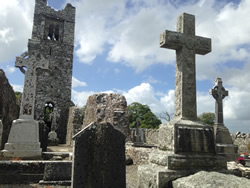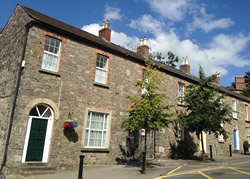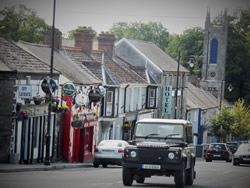The Search: When Roots Go Down to the Blood
by Scott Thomas Anderson
Originally
published October 1, 2015 in
The Press
Tribune

It’s amazing how forgotten, rain-faded etchings on a headstone can push your breath back and make you realize genealogy isn’t a hobby, it’s an existential rabbit hole that only gets more inviting the further you fall down it.
I recently went to Ireland to trace my family roots. Unlike most Americans feeling their way through the Diaspora, the investigative work had been done for me by my great uncle, George Birdsall, who’d trekked to the Emerald Island five decades before on his own adventure. George had obtained a charted history of my maternal grandmother’s family, the Flemings.

The Flemings were the barons of Slane in County Meath. It will come as no surprise to public officials familiar with my journalism that my ancestors were stripped of their wealth, lands and titles in 1690 due to their involvement in an ill-conceived fight. King James II, a Catholic, and King William of Orange, a Protestant, were engulfed in a war for dominion over the British Isles, and their final staggering confrontation happened in Ireland, near the lands of the Flemings. It’s come down through history as the Battle of the Boyne. A Protestant victory there set the stage for generations of violence and tragedy that lasted until 1924 in the Irish Republic, and until 2008 in Northern Ireland.
But to prove how addictive thumping through the DNA briar patch can be, that legendary defeat for Ireland’s Catholics at the River Boyne is quite literally the reason I exist today. That is to say, it’s why I exist as a lowly newspaper scribbler in California, rather than a wealthy, castle-dwelling, mead-guzzling man of influence in the Irish countryside. You see, in 1690 my ancestor Christopher Fleming, the 22nd Baron of Slane – another sucker for “the good fight” – not only sided with King James II, but literally helped him escape arrest in the hours after the battle.
Christopher Fleming was eventually captured and stripped of all claims binding him to the Anglo-Irish aristocracy. He was lucky to keep his head.
So how do I know all of this? In 1829, when Ireland was still under British rule, James Fleming – two generations above my great, great grandmother – applied to the House of Lords to be reinstated as the Baron of Slane. His request prompted the English government’s Ulster King at Arms to launch a five-year investigation that traced the Flemings’ lineage back 700 years. James Fleming could not have known how vital this would prove to the future research. Ireland’s own public records office was obliterated by an explosion in 1924 during the Irish Civil War.

My great uncle obtained the House of Lords’ inquiry. And here’s the story it told: The Flemings were Norman knights who invaded Ireland in 1170 with famed conquerors Maurice Fitzgerald and Strongbow (for whom an excellent hard cider is named, and served, in many of our area pubs). This makes my own chromosome puddle murky enough, as the Normans were Catholic, French-speaking invaders descended from Vikings who briefly ruled Europe’s coastlines west of Paris, and then all of England. The Normans who took over parts of Ireland stayed long enough, and intermarried enough, to be considered over the centuries “Anglo-Irish.”
In the mid-1830s James Fleming was evidently recognized by the English government as the rightful claimant to Slane’s barony, but nonetheless he was denied getting it back. Knowing the Flemings would never enjoy their former glory in Ireland, James made a new start in the American Midwest, in Illinois, where his granddaughter Sarah Fleming later married Edmund Birdsall, setting off a chain of events that would ultimately lead to my own arrival on the scene in California in late 1970s.
I can’t say I experienced some Hitchcockian feeling of recognition when arriving at Slane, though I was stirred by a sense of stepping into the pages of a Seumas O’Kelly story. I wandered through the town’s old cemetery staggered along a crumbling stone abbey on its hill. Moving through the grass and graves, I heard my wife call out to me from the front. There, under a medieval Celtic cross, was the storm-blasted remnants of the family Coat of Arms under the chiseled letters, Fleming. Before that moment, I could never have pictured a battered headstone like this connected to my blood. I looked at it in silence. It was unclear which, or how many, Barons of Slane were interred beneath it. To its immediate left were newer graves, only a century old, full of Flemings who had stayed in Ireland rather than join the Diaspora. Their names were readable, though each one only left me numbly curious about how our paths diverged so many decades before, leaving us unknown and permanent strangers to one another – family members split by a slaughter on a battlefield in a past far beyond our own memories.
